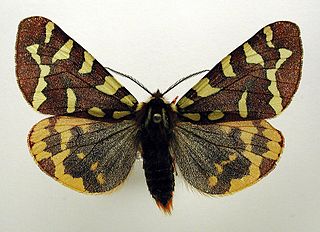
Arctia is a genus of tiger moths in the family Erebidae. Therein, it belongs to the subtribe Arctiina in the tribe Arctiini in the subfamily Arctiinae. Species are well distributed throughout North America, Palearctic, India, and Sri Lanka.

Arctia menetriesii, the Menetries' tiger moth, is a species of tiger moth in the family Erebidae. It was first described by Eduard Friedrich Eversmann in 1846. It is found in Karelia, Oktyabrskoe, northeastern Kazakhstan, Altai Mountains, Sayan Mountains, Evenkia, Yakutia, the central Amur region, Primorsky Krai and central Sakhalin. It was believed to be extinct in Fennoscandia, but the species has been recently recorded in Finland. This species is characterized by the fact that they never come to light; such behavior is atypical in the family Arctiidae.

Arctia tigrina is a moth of the family Erebidae. It is found on the Iberian Peninsula and the South of France and Italy.

Arctia lapponica is a moth of the family Erebidae first described by Carl Peter Thunberg in 1791. It is found in northern Eurasia and the Arctic part of North America.
Arctia khumbeli is a moth of the family Erebidae. It was described by Otto Bang-Haas in 1927. It is found in the Tian Shan of China.
Arctia ladakensis is a moth of the family Erebidae. It was described by Otto Bang-Haas in 1927. It is found in Tibet and Xinjiang in China.
Arctia weigerti is a moth of the family Erebidae. It was described by Josef J. de Freina and Thomas Joseph Witt in 1985. It is found in northern Pakistan (Karakorum).
Arctia bundeli is a moth of the family Erebidae. It was described by Vladimir Viktorovitch Dubatolov and Vladimir O. Gurko in 2004. It is found in Tadjikistan.
Arctia tancrei is a moth of the family Erebidae. It was described by Staudinger in 1887. It is found in Kazakhstan, Uzbekistan, Tajikistan, Kyrghyzstan and China.
Arctia gurkoi is a moth of the family Erebidae. It was described by Vladimir Viktorovitch Dubatolov in 2004. It is found in Pakistan and possibly Xinjiang, China.
Arctia subnebulosa is a moth of the family Erebidae. It was described by Harrison Gray Dyar Jr. in 1899. It is found in Alaska, Yukon and the Russian Far East.
Arctia allardi is a moth in the family Erebidae. It was described by Charles Oberthür in 1911. It is found in China.
Arctia buddenbrocki is a moth in the family Erebidae. It was described by Hans Kotzsch in 1929. It is found in Gansu and southern Shaanxi, both in China.
Arctia cupido is a moth in the family Erebidae. It was described by Yasunori Kishida in 1995. It is found in Nepal.
Arctia hannyngtoni is a moth in the family Erebidae. It was described by George Hampson in 1910. It is found in the north-western Himalayas and Nepal.
Arctia mirifica is a moth in the family Erebidae. It was described by Charles Oberthür in 1892. It is found in western China, Tibet and north-western India.
Arctia romanovi is a moth in the family Erebidae. It was described by Grigory Grum-Grshimailo in 1891. It is found in the north-western Chinese province of Qinghai.
Arctia forsteri is a moth in the family Erebidae. It was described by Franz Daniel in 1943. It is found in Sichuan, China.
Arctia kasnakovi is a moth in the family Erebidae. It was described by Vladimir Viktorovitch Dubatolov in 1987. It is found in Qinghai, China.
Arctia sieversi is a moth in the family Erebidae. It was described by Grigory Grum-Grshimailo in 1891. It is found in Qinghai, China.



